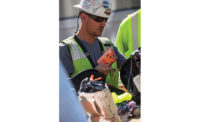Ponder this: our human reality now involves a Bluetooth toaster. For $100, you too can receive push notifications when your slice of bread reaches the desired level of toasted-ness. Yes, this is almost certainly the future Steve Jobs envisioned when introducing the iPhone as a “revolutionary and magical product”.
Welcome to the wonderful world of IoUT (Internet of Useless Things).
But among the $50 water bottles (that tell you when to refill them... yup, really) and $65 forks (that let you know if you’re eating too fast… seriously) there’s the IoAUT (Internet of Actually Useful Things). Smart thermostats. The ability to shut your garage door and turn lights off from another time zone. Remote healthcare monitoring and emergency notification systems. Truly good and useful and amazing stuff.
And in the world of industrial safety, forward-thinking manufacturers are turning personal protective equipment into personal preventive equipment – giving workers the power to proactively address specific safety risks in real-time. Data that comes from embedded sensors in smart PPE is not only being used to improve individual safety, but also connecting that information to a greater platform in order to improve safety (and efficiency) for all.
Getting return on investment
As employers continue to spend billions of dollars annually on worker safety programs, injury rates over the past several years have remained stagnant. That statistical plateau has leaders in the safety industry tapping into another resource to take worker safety to the next level: the workers themselves – connecting smart PPE to a platform focused on producing real-time data to and from workers on key safety categories like PPE management, risk management, safety communications and worker engagement.
Workers play a key role
“There’s a frustration that the spend on safety initiatives is no longer yielding the results that it had been for decades,” said Tom Votel, president & CEO, Ergodyne.
Connected worker platforms aim to enable a proactive, risk-based approach to safety using leading indicators (as opposed to lagging, reactive indicators) to help companies best manage their resources and processes, without compromising efficiency or productivity. The end game: empowering workers to play a major role in ensuring a safe work environment for everyone.
“I think safety is a conversation between the worker and the employer,” said Votel, “More and more, people are understanding that workplace safety goes far beyond how much was spent on a pair of gloves. It’s about how we are driving compliance. Are we having the conversation with our workers and are workers actually engaged in the process to help us make safety better?”
Adding brains to PPE
Take your typical hi-vis vest. It reflects light and prevents struck-by accidents etc., but it’s inert. The idea with connected safety and smart PPE is taking that inert product and adding a “brain” to it, so that it can gather and share information. Feed all that info-rich data into a software platform, and that’s where are all kinds of interesting things start happening.
A simple example of connected safety in action would be in the realm of heat stress. A smart hi-vis vest or work shelter could communicate all sorts of important information to a worker through a system-administered mobile device – notifying them of dangerous heat index levels or when it’s time to find a shady spot for a water break. With real-time alerts, visual information and communication, crews are armed with what they need to be smarter, safer and more productive while working in challenging environments.
Leveraging intelligent safety gear to accelerate meaningful communication between safety professionals and workers – and the time it takes to act upon it – means not only preventing injuries, but, from a very practical business sense, reducing costs, increasing productivity and worker-level investment in the company’s success as a whole.
Millennial takeover
The current workplace safety transformation is as generational as it is technological. A transference of leadership is happening right now. “About 50 percent of the safety managers are going to be replaced in five years,” said Votel. “That’s really significant.”
Relating to this growing community of digitally native leaders and workers will be absolutely critical from a safety perspective.
The good news? We have the technology to foster that relationship. “Of course, it’s up to us Baby Boomers to shepherd this generational/technological convergence,” said Votel. “The next wave lives in the digital world. We need to make a commitment to help the future generation of leadership harness technology and advance the cause of safety.”
And in a tight labor market, younger workers undoubtedly will find this to be the more attractive and enabling approach compared to those organizations still cutting corners and digging their heels in against the approaching safety-tech tide.
Pro-safety, not Big Brother
In a world where every move is caught on camera, recorded and tracked by GPS, there’s the obvious concern that “connected safety” is code for yet another Orwellian invasion of privacy, the newest unblinking eye of the surveillance state.
The power of the platform is the ownership it gives workers over their own safety and the voice given to those on the front lines, shifting the paradigm of top-down, management-driven programs. Though tracking elements do exist with smart PPE and industrial safety software platforms, advocates contend it’s as pro-worker and free of bureaucratic bottlenecks as a safety initiative can be.



